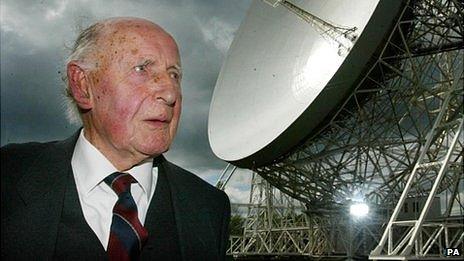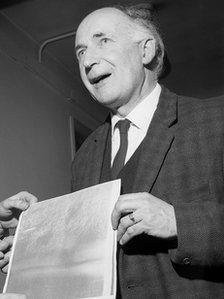Obituary: Jodrell Bank founder Sir Bernard Lovell
- Published

Jodrell Bank's centrepiece was renamed the Lovell Telescope in honour of Sir Bernard Lovell in 1987
Sir Bernard Lovell developed the science of radio-astronomy in the UK and was director of Jodrell Bank, the site of the country's largest radio telescope, for 30 years.
When he was developing his idea for a radio telescope in the 1950s, he faced much hostility over the cost of the project.
But this criticism turned to wonder and acclaim when, in October 1957, the telescope showed that it could accurately track the first Soviet sputnik spacecraft.
It soon became one of the most famous scientific instruments in the world, recording radio emissions from outer space and setting the pattern for other radio astronomy observatories.
In 1987 it was renamed the Lovell Telescope in honour of its creator.
Sir Bernard was born in 1913 in a village near Bristol, where his father ran a small radio repair shop and petrol station, besides being a Methodist lay-preacher.
He read physics at Bristol University, won a research scholarship, became an assistant lecturer at the University of Manchester and studied cosmic rays under Professor PMS Blackett.
During World War II, he was seconded to the Telecommunications Research Establishment.
Cosmic rays
It was while working there, in the field of radar, that his thoughts first turned to the possibilities of cosmic exploration through radio.
At the end of the war he resumed his post in Manchester, carrying on his work in a field in Cheshire, where he formed the nucleus of what was to become the Jodrell Bank station.
At first, he used old Army radar equipment to detect cosmic-ray bursts and to investigate meteors.
But he soon found that he needed a bigger radio collecting mirror, and built one himself with a diameter of 66 m (218 ft).
It was, however, a fixed device, and looked into space in only a narrow range of directions.
The next requirement was another radio telescope, at least as large, and this time accurately steerable, so that it could be pointed to any part of the sky.
The difficulty was finding people who believed in the idea and were prepared to finance it. However, the money - some £700,000 - was eventually raised and by 1958 the telescope was in action.
Deep probes
The tracking of the sputniks and moon-probes was only a part - and from a scientific point of view, not the most important part - of the telescope's work.

The Lovell Telescope received the first detailed picture of the moon in 1966
This involved the study of the remotest parts of the universe, millions of light years away, far beyond the range of rockets and satellites.
It extended our understanding of stellar objects, such as quasars, and provided a valuable insight into the origins of the universe itself.
Later in life, Sir Bernard became very concerned about the effect that short-term national and military projects might have on the interests of pure science.
He strongly opposed schemes like the US plan to put a belt of radio-reflecting needles into space.
In 1958 he gave the BBC Reith Lectures, titled the The Individual and the Universe, in which he examined the history of and then-current inquiry into the solar system and the origin of the universe.
Knighted in 1961, he was President of the Royal Astronomical Society from 1969 to 1971 and, in 1975, he served as President of the British Association for the Advancement of Science.
Sir Bernard wrote many books and was honoured by universities and institutions all over the world. He married in 1937, and had two sons and three daughters.
- Published7 August 2012